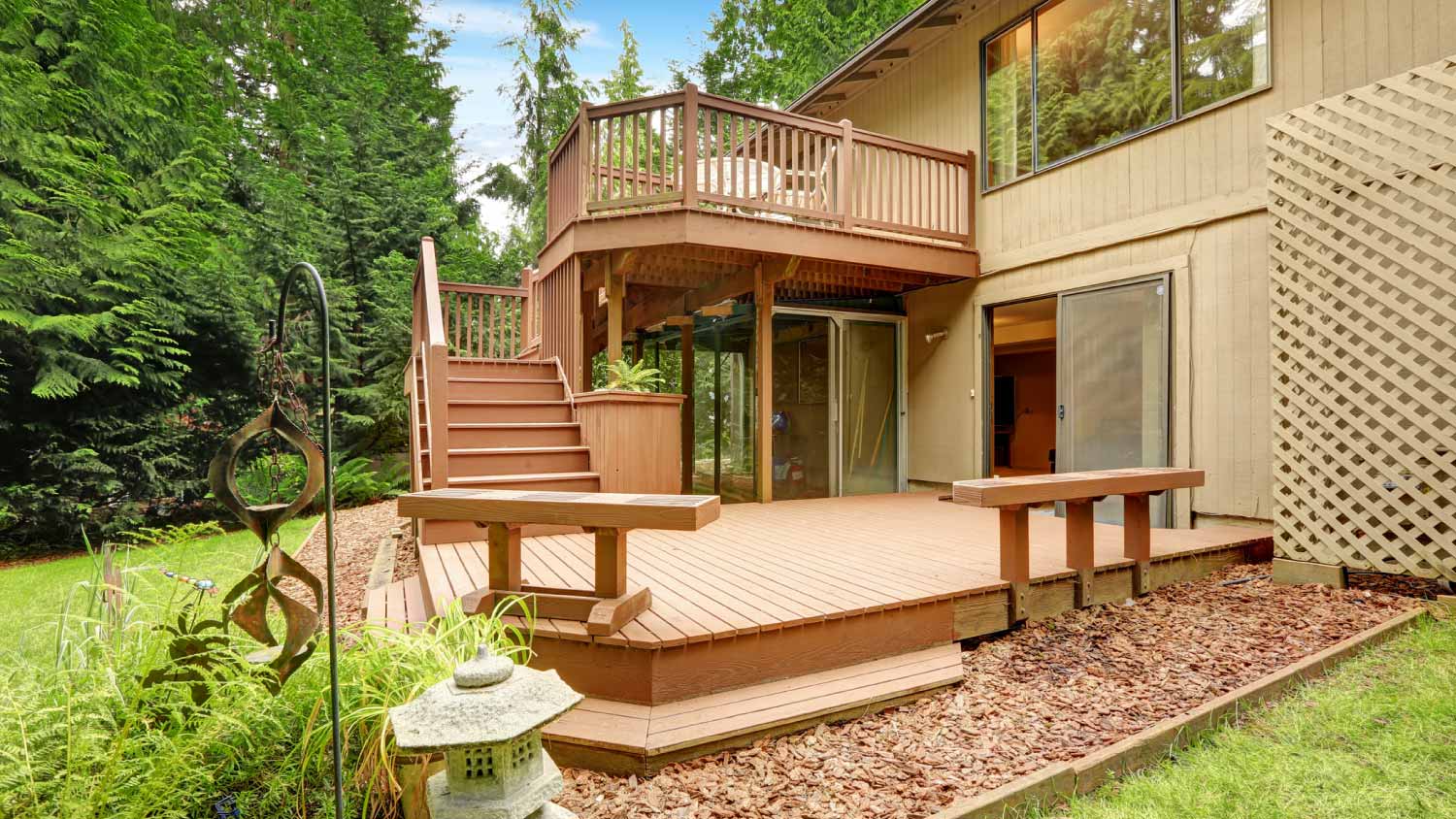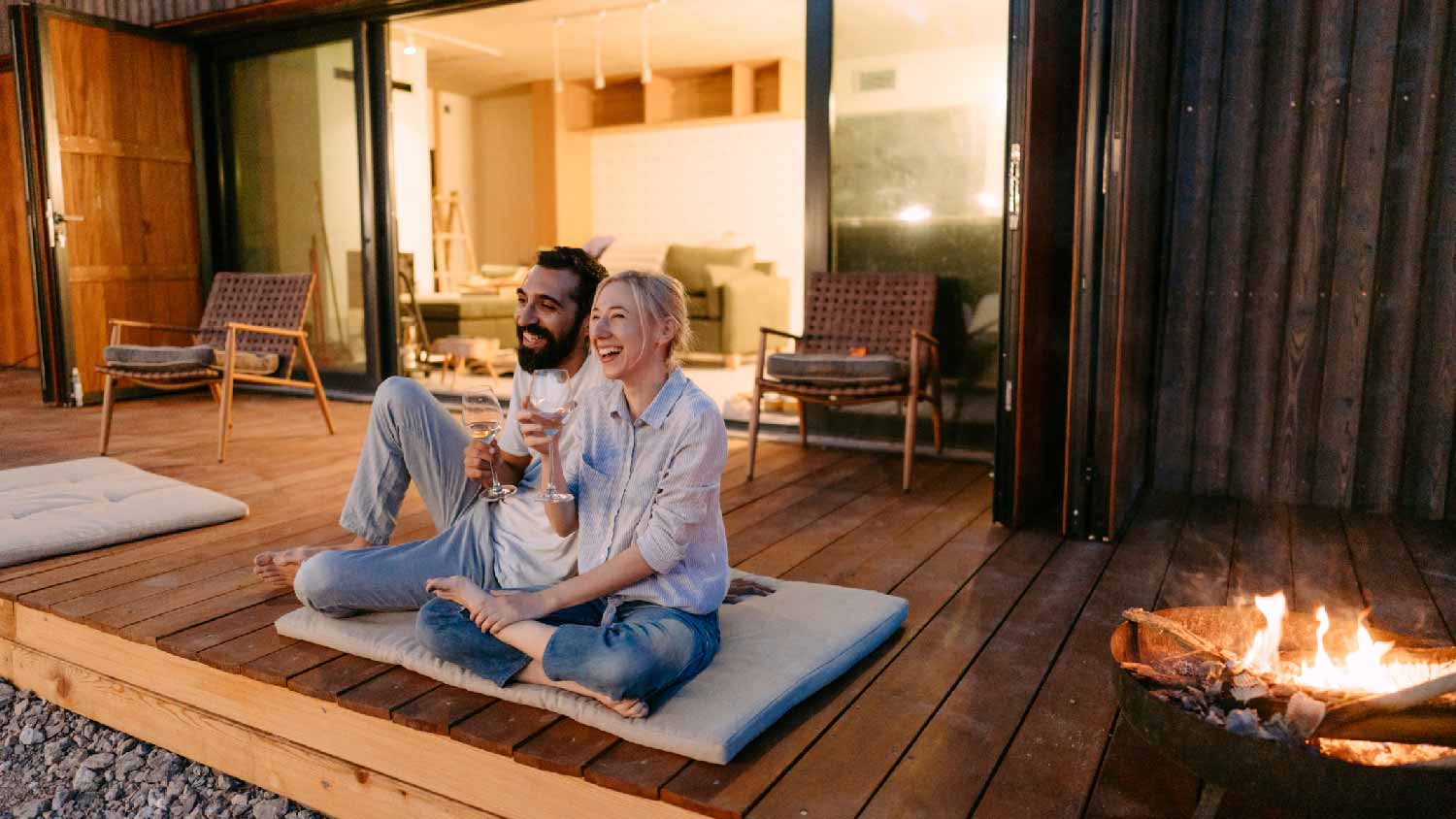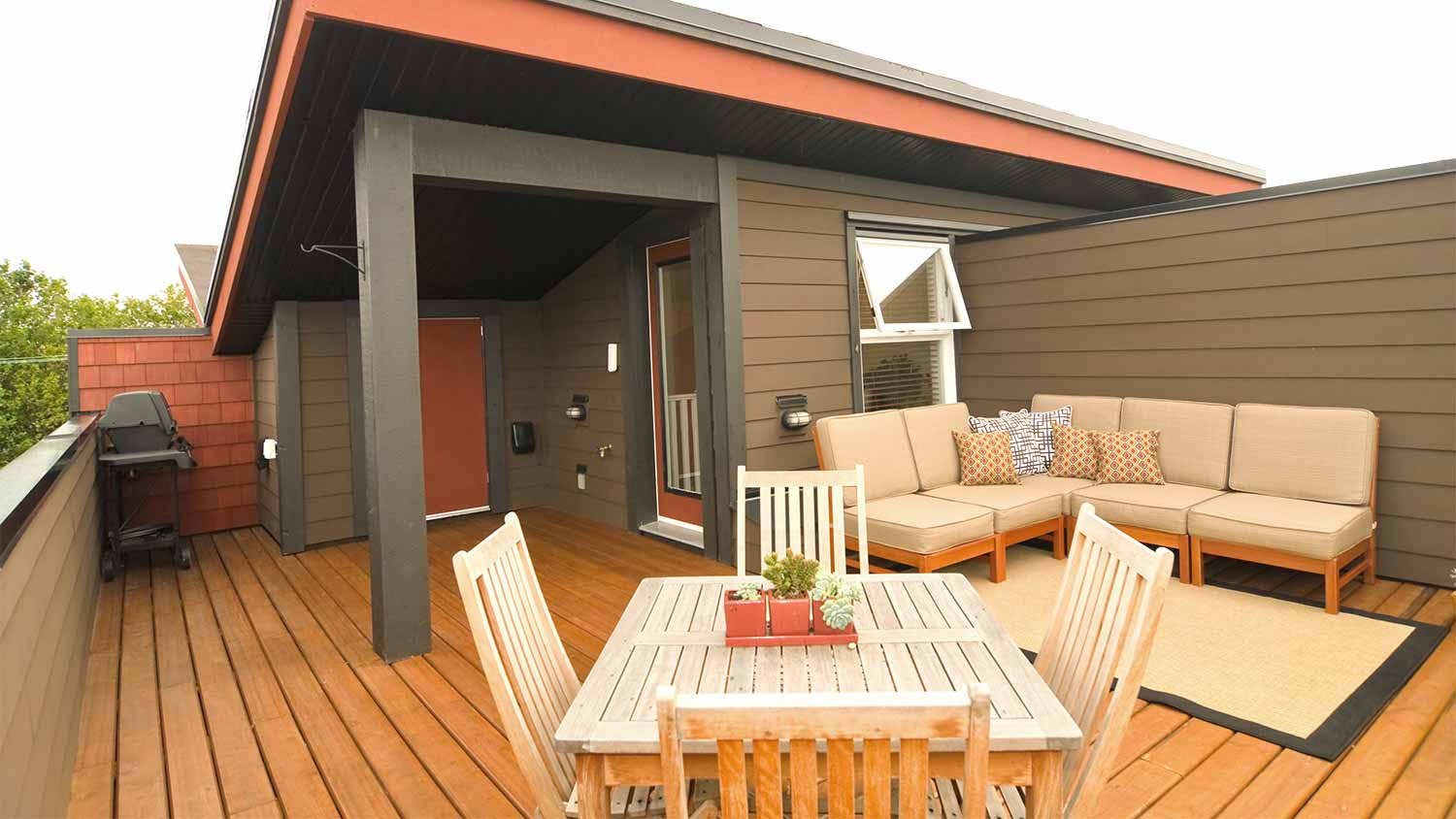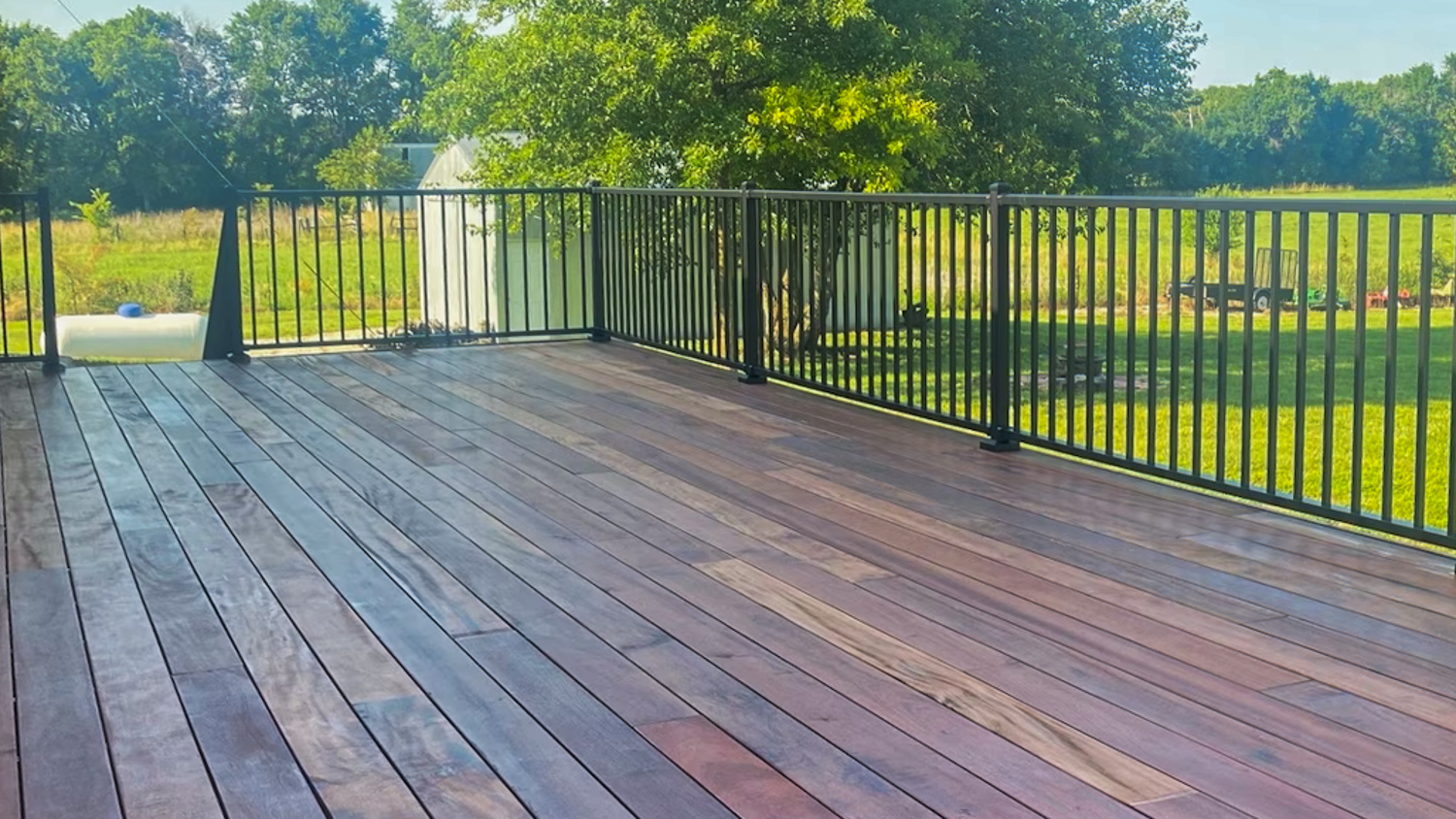
Vinyl is a durable and relatively inexpensive choice of decking material. Your vinyl deck cost will depend on labor, the deck size, and more.
The average cost to build a second-story deck is between $3,600 and $6,000, with variation based mostly on square footage and decking material. Most homeowners pay about $4,800.


Decking labor and materials cost an average of $40 to $50 per square foot.
The biggest cost factor for a deck is the type of decking material used.
Adding a staircase, awning, paint, or sealant to the deck will increase costs.
Improper installation can cause collapse, so DIY installation isn’t recommended.
On average, building a second-story deck costs $4,800, though it can range anywhere from $1,000 to $16,000 depending on the size of the deck and the decking material you use. On average, you can expect to pay between $40 and $50 per square foot.

The biggest factors in second-story deck installation cost are deck size and decking material. Several other factors also play a role.
Accounting for both labor and materials, the average second-story deck costs $40 to $50 per square foot. Depending on the material used, you may pay anywhere from $30 to $90 per square foot. There is no standard deck size, so your total cost can vary greatly depending on the total square footage of your project.
| Deck Size (Square Feet) | Price Range |
|---|---|
| 25 | $1,000–$1,250 |
| 50 | $2,000–$2,500 |
| 100 | $4,000–$5,000 |
| 120 | $4,800–$6,000 |
| 260 | $10,400–$13,000 |
| 320 | $12,800–$16,000 |
| Deck Material | Average Cost (per Square Foot) |
|---|---|
| Pressure-treated wood | $2–$5 |
| Cedar | $3–$7 |
| Bamboo | $3–$10 |
| Mahogany | $8–$11 |
| Tigerwood | $7–$15 |
| Ipe wood | $10–$20 |
Below is a breakdown of each material and its costs:
Pressure-treated wood costs $2 to $5 per square foot. This common decking material is durable, but high-maintenance.
Cedar decking costs $3 to $7 per square foot. It resists bugs, moisture, and UV rays.
Bamboo decking costs $3 to $10 per square foot. It's strong and resistant to mold and rot, but it's not suited for colder climates.
Mahogany decking costs $8 to $11 per square foot and is relatively low-maintenance.
Tigerwood decking costs $7 to $15 per square foot and has a distinct striped pattern that many value for its aesthetic appeal.
Ipe wood decking costs $10 to $20 per square foot. This material is extremely durable, but it also typically comes with higher labor costs.
Composite decking costs $12 to $22 per square foot. This sustainable decking material is made mostly of recycled materials.
Aluminum or metal decking costs $15 to $20 per square foot and makes for a long-lasting, low-maintenance waterproof deck.
Redwood decking costs $5 to $35 per square foot. This wood naturally repels pests.
Labor for a second-story deck installation costs $10 to $45 per square foot on average, accounting for 30% to 50% of the total project cost. You'll pay slightly more to hire a deck building contractor for an elevated deck than a ground-level deck due to the extra time and expertise required to build a raised framework, as well as the increased insurance costs.
Second-story decks are more common in warmer parts of the country, such as the southwest and southeast. Since labor and materials are more readily available in these regions, costs tend to be lower on average. Similarly, you'll pay more to install a second-story deck in colder, northern regions.
Most jurisdictions require a permit to construct a new deck. The average permitting and inspection fees for an elevated deck total about $500.
A rectangular deck is the most common design and is easiest to construct. If you want a specialty shape, your project will require additional planning, labor, permitting, and material waste. Expect project costs to increase by anywhere from 50% to 100% for a specialty deck shape.
While a ground-level deck can be a DIY-friendly project, a second-story deck is not. Elevated structures can collapse if not built to handle specific loads, resulting in serious injury or property damage. Instead, contact a local deck builder to handle the structural aspects of the job.
There are various optional costs for a deck-building project. An awning can offer shade and protection from the elements, while sealing or painting can protect your deck and help increase its lifespan. Note that a staircase may be required in some regions due to local fire codes.
Awning: $800–$5,000
Deck sealing or waterproofing: $400–$2,100
Deck painting: $500–$2,000
Deck staircase: $1,000–$2,000
Prefabricated stairs: $800–$1,000
You can do many things to reduce the overall cost of a second-story deck:
Opt for more affordable materials, such as pressure-treated wood
Choose a simple rectangular design
Do your own prep by clearing the work area ahead of time
Handle the DIY-friendly aspects of the project yourself
While it's not advisable to build a second-story deck as a DIY, parts of the project are still DIY-friendly. Deck paint only costs about $40 to $120 per gallon, and you can save over $1,000 by handling the painting yourself.
The same goes for the cost of the deck railing. If you have carpentry skills and can make accurate measurements and cuts, you can save around $700 on average by installing a railing yourself.
Home is the most important place on earth, which is why Angi has helped more than 150 million homeowners transform their houses into homes they adore. To help homeowners with their next project, Angi provides readers with the most accurate cost data and upholds strict editorial standards. We extensively research project costs to develop the pricing data you see, so you can make the best decisions for you and your home. We rely on reputable sources, including the U.S. Bureau of Labor Statistics, academic journals, market studies, and interviews with industry experts—all to ensure our prices reflect real-world projects.
Want to help us improve our cost data? Send us a recent project quote to [email protected]. Quotes and personal information will not be shared publicly.
From average costs to expert advice, get all the answers you need to get your job done.

Vinyl is a durable and relatively inexpensive choice of decking material. Your vinyl deck cost will depend on labor, the deck size, and more.

Ipe decking costs vary based on size, construction, finish, and whether you hire a professional. Learn more about how to budget for this project.

Cedar is a popular decking material, best known for its natural wooden look and resistance to rot. So, how much does a cedar deck cost? Find out in this guide.

Decks provide usable outdoor space for relaxing and entertaining. But do decks add value to a home? Find out the answer in this informative guide.

Discover rooftop deck costs, key price factors, and ways to save. Learn what impacts rooftop deck installation costs and how to budget for your project.

Discover the average tigerwood decking installation cost, key price factors, and tips to save. Get expert guidance for your decking project.